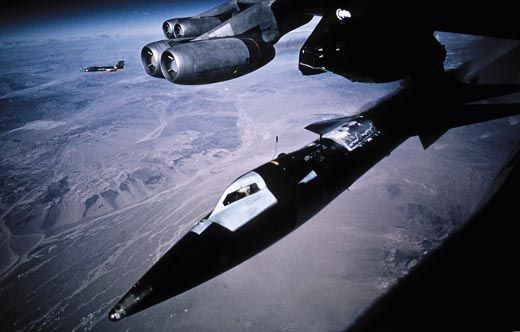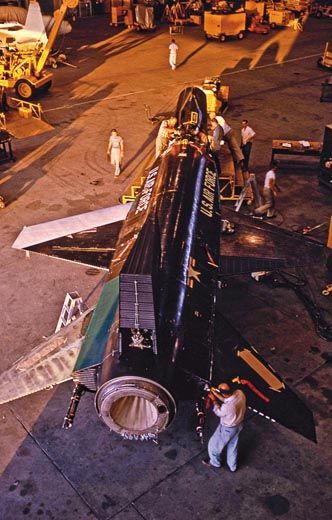An Extra Two Seconds
This is how test pilot Bob White set a records in the X-15
/https://tf-cmsv2-smithsonianmag-media.s3.amazonaws.com/filer/Above%20and%20Beyond%20An%20Extra%20Two%20Seconds%20M.jpg)
In the cockpit of the sleek, black aircraft slung underneath the wing of the B-52 bomber, my interphone crackles. "Ah, Robert, it’s a lovely morning," says Jack Allavie, the commander of the B-52 launch aircraft.
"Yes it is, Jack," I respond while running through the preflight checklist for our July 17, 1962 mission.
The North American Aircraft X-15 was designed to investigate flight at hypersonic (Mach 5-plus) speeds and extremely high altitudes, and the effects of aerodynamic heating on aircraft surfaces. It was the first aircraft to fly Mach 4, Mach 5, and Mach 6—and I had the good fortune to be the pilot of these flights. I was also the first to fly faster than 3,000 mph and the first to fly above 200,000 feet. Today we would try to best that altitude by another 100,000 feet.
I finish the checklist. The flight has been aborted three times, so the crew—drop pilots Allavie and Harry Archer and panel operator Stan Butchart—is anxious to get it going today. Fellow X-15 pilot Joe Walker will be "NASA 1," mission control on the ground. Walker and I, with Scott Crossfield and Forrest Peterson, are to fly to Washington, D.C., later today to meet with President Kennedy. He’ll present us with the Collier Trophy for our work with the X-15 program—a grand honor, as the trophy is awarded for "the greatest achievement in aeronautics…in America" each year.
Allavie fires up the B-52 and requests ground control clearance to taxi out: "Eddie tower, this is zero-zero-three, taxi."
"Ready to roll, buddy?" Jack radios.
"Ready when you are, Jack." As we taxi, the starters and ladders are pulled away from the F-104 and T-38 for chase pilots Jim McDivitt and Jack McKay.
I hear Allavie over the interphone: "Say Bob, the temperature is up a bit. It’s going to be a long run to unstick today"—meaning the B-52 will need a long ground run to get airborne. He knows he just opened the door for some fighter-versus-bomber banter, and I do not disappoint. "Sure you and Harry can manage, Jack? I’ll be happy to crawl over and give you a hand if you have any little problems."
"Bob, you know we never let beginners fly this thing," he replies. "You just stick to your toy airplanes and leave the real flying to the pros."
The climbout goes smoothly. The drop pilots will breathe easier after we pass 26,000 feet. Below that altitude, they cannot release the X-15 in an emergency; I would not have enough time to fully jettison the propellants. The excess weight of residual propellants would result in a faster-than-normal landing, and that extra weight could cause structural failure. We had discovered the problem when an X-15 landed with residual propellant: Its fuselage buckled and landing gear collapsed. Above 26,000 feet, the X-15 pilot can either bail out or vent the tanks and land.
During our ascent some of the liquid oxygen (LOX) has boiled off. I have the panel operator top it off. I’ll need all the fuel and oxidizer I can get to surpass 300,000 feet.
We’ve been flying northeasterly en route to the Delamar Lake launch point. Allavie has to time his 180-degree turn to launch me precisely: Being slightly off course could greatly displace the X-15 from the planned route, especially during reentry.
Initially, the B-52 pilot dropped the X-15. But if a pilot tried to yell over the interphone that he wasn’t ready, he might not be heard, and on one flight, the X-15 was very nearly dropped before the pilot was ready. Now the X-15 pilot has complete control of the drop.
One minute prior to launch, I see that a glitch causes the Minneapolis Honeywell MH-96 flight control system to shut down. The "Mini-Honey" takes into account the variables that occur over a vast range of altitudes and speeds—temperatures, atmospheric and dynamic pressures, and more. Without it, the aircraft might not be controllable during reentry. (A precursor to the "fly by wire" systems in virtually all current military aircraft, the MH-96 made the X-15 easier to control with either the aerodynamic control system for flight in the atmosphere or the reaction control system, which was used at very high altitudes where there is no discernible atmosphere.)
Standard procedure says to abort if this system is not working. The MH-96 had been thoroughly tested in prior flights by Neil Armstrong, and performed well. So it’s understandable that when a shutdown occurs, things get a little tense in mission control and on board the B-52.
I do a reset; the MH-96 comes back.
As Allavie rolls the B-52 onto the heading of 222 degrees, at the launch speed of 0.82 Mach, I start the first-stage ignition. Think of this as a pilot light on a gas stove; there is no real power yet because it’s "idling." Joe Walker calls the countdown: "Four…three…two…one…LAUNCH!"
I flick the "Drop" toggle switch. The X-15 falls away and I shove the throttle forward. The acceleration is tremendous, and as I pitch up in a 40-degree climb, the G-forces build. X-15 pilot Bill Dana was fond of saying that because of the 4 Gs against the chest endured during powered flight, the X-15 is the only aircraft in which he was glad when the engine quit.
The plan called for an 80-second burn to reach 282,000 feet and Mach 5.15. But this engine performed very well, and by topping off the LOX, I was able to burn the engine for an extra two seconds, which allowed me to accelerate to Mach 5.45 and peak at 314,750 feet, becoming the first person to fly an aircraft above 300,000 feet and also the first pilot to fly a winged vehicle into space.
The X-15 now starts to decelerate. I can feel the MH-96 firing. At this altitude my standard controls are ineffective, so the MH-96 is now using jets of hydrogen peroxide to control yaw, pitch, and roll, keeping the nose on the proper heading.
While I am enjoying the view, I startle Walker when I transmit: "There’s something out there." He does not know if I mean something is going wrong with the flight, or if something is out there flying along with me.
No time to worry about this now; reentry is fast approaching. When it begins, the "eyeballs out" negative G forces start to build. I place my helmet against the reverse headrest, which allows my helmet to settle forward slightly and stay in place as the aircraft decelerates and the pressures on my body increase. Without this headrest, the negative G forces would push my head so far forward I could lose sight of the control panel.
The X-15 soon encounters enough atmosphere to regain the use of the aerodynamic control surfaces. Coming out almost directly over Edwards Air Force Base, we are still at Mach 3-plus and around 75,000 feet, much faster and higher than previous X-15 flights. Overflying the landing site, I make one circle and roll out on heading, having lost enough altitude to be right on target for the lakebed runway. The Gs are so great that after the flight I find a huge patch of burst capillaries all over my right shoulder and chest (it disappears after a few days).
I was highly satisfied with the touchdown, but I had to get ready for the flight to Washington, so there was no time for a formal debrief. However, some of the engineers and staff did ask me about my comment that there was "something out there." I described the object as the color of cardboard, about six feet by six feet, and explained that it flew formation with me briefly. They scratched their heads and looked at me funny, but let me go.
Later, the engineers and others reviewed the film from a wide-angle camera mounted above and behind the cockpit, facing rearward. The footage showed something flying by. To this day no one is sure what it was, but the consensus is it was likely ice that had broken loose.
At the time, four Americans had earned astronaut wings: Project Mercury’s Alan Shepard, Gus Grissom, John Glenn, and Scott Carpenter. With that X-15 flight, I became the fifth.
Bob White, who passed away on March 17, 2010, was a retired major general in the U.S. Air Force. Al Hallonquist has studied aerospace history since high school, when he learned to fly.

